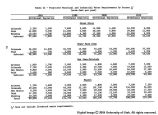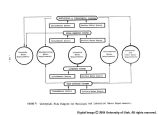| OCR Text |
Show PART II PRESENT STATUS not be palatable and may have a laxative effect on new users. Sodium sulfate and magnesium sulfate are well known laxatives. The presence of excessive concentrations of nitrates can have serious physiological effects causing infant methemoglobinemia. Hardness describes a quality characteristic of water mainly attri- butable to the presence of calcium and magnesium ions. Hardness has a detrimental economic effect, resulting in excessive soap consumption, fabric wear and scale formation. It is generally accepted that hardness concentrations greater than 120 mg/1 (as CaC03) should be softened in order to save money and produce a better result in laundering operations. Some chemical constituents in water, such as iron, copper, zinc and possibly manganese, are essential for human nutrition. However, concen- trations of these chemicals in water sufficient to meet nutritional requirements can be esthetically or economically undesirable by causing tastes, stains, and deposits. Since most diets provide ample amounts of these chemicals to satisfy nutritional requirements, the recommended limits of these chemicals are set to prevent the undesirable esthetic and economic effects. Excessive concentrations of virtually all chemical constitutents in water have toxic physiological effects on humans if consumed in a short period of time. The detrimental effects on domestic water uses of pesti- cidal chemicals such as DDT, dieldrin, and endrin, which are consumed continuously over long periods of time, are uncertain; but indications are that they may have toxic effects and may cause taste and odor problems. Chemical constituents such as lead, arsenic, mercury and cadmium are toxic cumulative poisons which are not readily eliminated from the body. The toxic effects of these chemicals result from continuous consumption over a long period of time. Fluoride is toxic to humans in excessive concen- trations, but in small concentrations it has the beneficial effect of reducing dental decay, especially in some children. Radiation exposure can have harmful effects on humans. Radioactivity intake from all sources such as water, food and air must be limited. Water within the radiation limits shown in Table 7 is acceptable without further consideration of other sources of radiation. Biological and microbiological characteristics of domestic water must be limited to prevent harmful esthetic and physiological effects. Sapro- phytic bacteria found in natural waters perform a variety of beneficial functions, including the dissolution of decaying organic matter and the concentration of elements essential to life. However, the presence of these bacteria in domestic water can cause undesirable tastes, odors, and colors. Domestic water should be free of pathogenic bacteria which can cause such diseases as dysentery, typhoid fever, parathyphoid fevers, cholera, and gastroentenitis. Domestic water should also be free of 19 |

















































































